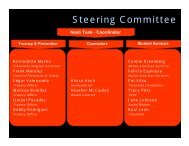Creating a Culture of Success - Sunnyside Unified School District
Creating a Culture of Success - Sunnyside Unified School District
Creating a Culture of Success - Sunnyside Unified School District
Create successful ePaper yourself
Turn your PDF publications into a flip-book with our unique Google optimized e-Paper software.
First day <strong>of</strong> school 2010Students began school onThursday, August 10, 2010
8th Grade Digital ScholarsMore than 250 <strong>Sunnyside</strong> <strong>District</strong>incoming freshmen achieved the“Four As” as eighth-graders andstarted their first day <strong>of</strong> school withtheir own netbook computer.Netbooks were awarded onWednesday, August 4 at both DesertView and <strong>Sunnyside</strong> high schools.
Ocotillo Early LearningCenter opensfor 2010-11Ocotillo has re-opened as an earlychildhood education and familycommunity facility where the district canconsolidate its preschool programs and<strong>of</strong>fer a more comprehensive approach toearly childhood education.
Apollo to become a community schoolA grand opening celebration for Apollo Community <strong>School</strong> will beheld on Monday, Aug. 23, 5:30 – 7:30 p.m. The community school willprovide tutoring, technology training, nutrition and fitness classes,and other services for families.
SLIDES FROM MISTI• Librarian, • Extracurricular Eighth-grade Digital EveryOcotillo Free One-to-one all-day Early kindergartencomputing Learning Centerfor Technology All Dropout five <strong>Sunnyside</strong> Scholars SUSD registered Recoveryfifth-graderstraining Digital middle activities in <strong>District</strong> high nurse, provides Scholarsfor schoolparents fromcounselor, championship schools start earn online laptop high courses has are art school a Performing teacher, computers full-time: wrestling and with online music their and Plusownteacher, football laptop take networking Arizona online physical computer to LEARNS mariachi courses education and hip teacher hop
Video<strong>Sunnyside</strong>PRIDE
Transformation Through Technologya Tech Savvy <strong>District</strong>
Administrator Pr<strong>of</strong>ileJuly-August Magazine
5th Grade Parent Night•August 18th at <strong>Sunnyside</strong> High<strong>School</strong> at 6 p.m.•Celebrating Technology•5th students are the future•Invite parents to be our ambassadors•Marketing for open enrollment
<strong>Sunnyside</strong> <strong>Unified</strong> <strong>School</strong> <strong>District</strong>From preschool to college prep, preparingstudents for success (DRAFT)• Ocotillo Early Learning Center• Free all-day kindergarten• One-to-one computing for fifth-graders• Technology training for parents• Extracurricular activities from championship wrestling andfootball to mariachi and hip hop• All five SUSD middle schools are Performing Plus in ArizonaLEARNS• Apollo Community <strong>School</strong>
<strong>Sunnyside</strong> <strong>Unified</strong> <strong>School</strong> <strong>District</strong>• Eighth-grade Digital Scholars start high school with theirown laptop computer• Digital Scholars in high school earn laptop computers andtake online courses (college readiness)• Dropout Recovery provides online courses and onlinenetworking (poster)• Every <strong>Sunnyside</strong> <strong>District</strong> school has a full-time:LibrarianRegistered nurseCounselorArt teacherMusic teacherPhysical education teacherParent Involvement Assist
1-to-1 computingis changing what and how we learn.Our goalis acomputerfor everystudent.Computación 1-a-1está cambiando nuestro aprendizaje.Nuestro objetivo es que cada alumnoindividual tenga el uso de unacomputadora.
Opening <strong>of</strong> <strong>School</strong> Celebration 2010
Welcome Back!<strong>Creating</strong> a <strong>Culture</strong><strong>of</strong> <strong>Success</strong>Opening <strong>of</strong> <strong>School</strong> Celebration 2010
<strong>District</strong> Challenges•Budget crisis•Academic challenges•Technology integration/1:1•Arizona’s political climate•Attendance and Truancy•Student Data
BudgetCrisis
Budget CrisisFinancial Challenges• Arizona’s budget deficit will continue to impact K-12 education.• FY 2011’s M&O budget is reduced by $5.4 million.• S<strong>of</strong>t capital was all but eliminated, with a reduction from $3.7 millionto $600,000.• <strong>School</strong> Building Renewal funds are being withheldfor the second year in a row.• For the first time in SUSD’s history, we’re starting the new school yearwith a reduction in force (RIF) <strong>of</strong> 100 positions and a five-day furlough.• We face potentially declining enrollment because <strong>of</strong> SB1070.• Supply allocations to all schools and departments, exceptMaintenance and Transportation, will be reduced by 25%.
SUSD’s Reactive Response• Closed Ocotillo Elementary <strong>School</strong> to save preschool andkindergarten programs.• Instituted a reduction in force.• Repurposed prevention specialists and other positions toutilize Title and stimulus funds.• Applied for and received more than $8 million in federalstimulus funds.• Increased class sizes K–12.• Froze key central <strong>of</strong>fice administrative positions.• Achieved savings through maximizing alignmentand efficiency.• Supply allocations to all schools and departments, exceptMaintenance and Transportation, will be reduced by 25%(recommended to be restored).
ChallengesArizona’s Political Climate
ChallengesArizona’s Political Climate• <strong>District</strong> continues efforts to meet the mandate <strong>of</strong> thefour-hour English Language Development model.• SB 1070 is creating fear and a climate <strong>of</strong> tension betweensupporters and opponents <strong>of</strong> the law.• Anchor baby legislation is pending.• Third-grade retention law.• Anti-immigration legislation threatens enrollment anddelivery <strong>of</strong> services to SUSD families.• How we address SB 1070 in the classroom will have to be welldesigned.
<strong>Sunnyside</strong> <strong>Unified</strong> <strong>School</strong> <strong>District</strong>Governing Board
Maintaining our commitments• Academic <strong>Success</strong>•Literacy•Quality first instruction•<strong>School</strong> improvement•Core CurriculumCompetencies• Safe and Orderly•Truancy and attendance•Alarm systems•STAR redesign• Technology Integration• Expansion <strong>of</strong> 5 th -Grade1-to-1 districtwide• Technology infrastructure anddepartment support• Digital Scholars classes• Teacher laptops• Maintaining our <strong>Sunnyside</strong>traditions for our community•Preschool and all-day kinder•Community schools•Librarians•Counselors•Art and music teachers•Registered nurses•Athletics
Truancy and Attendance MonitoringHigh <strong>School</strong> 9th Grade 10th Grade 11th Grade 12th GradeStar<strong>Sunnyside</strong>Desert View21.2% 15.4% 14.1% 21.6%7.2 7.1% 8.2% 9.6%9% 8.9% 8.9% 10.5%Implications for Policy consideration: The Loss <strong>of</strong>$720,750
Safe and OrderlySupport Structures• New Alarm Systems installed• Upgrade <strong>of</strong> Program Manager Position to Dean <strong>of</strong> Students(Administrator Position)• Special Education Behavior Resource Specialist Position for eachHigh <strong>School</strong> (Non-Administrative and Paid for out <strong>of</strong> 6B Funds)• Credit Recovery Labs at both Comprehensive High <strong>School</strong>s• Restructure Advisory to include tutoring and better attendancemonitoring• CLAW/DEVILS <strong>School</strong> within a school for Freshman andSophomore Students
AcademicChallenges• <strong>District</strong> Corrective Action, AYP,AZ LEARNS accountability standards• Literacy levels—significant number <strong>of</strong>students reading below grade level• Cohort graduation rate challenge• Inconsistent system to increase EnglishLanguage Learners’ academic pr<strong>of</strong>iciency(four-hour model)• Special education needs
<strong>District</strong>ChallengeMeet the challenges<strong>of</strong> the AYPand AZ LEARNSaccountability systems
SENSEOF URGENCY• Technology expansion• Curriculum blueprint• Safe and orderly• Star redesign• Attendance and truancy• Project Graduation• Literacy interventionexpansion with Reading Plus(6-9) and Read 180 and System44 ( 6-8)
SUSDCurriculumBlueprint
<strong>District</strong> Challenge• Literacy levels—A significant number <strong>of</strong> students are readingbelow grade level, resulting in these AIMS scores:###!"#$"%&'(")*+),&-."%&/)!"#+*#01%()'&)223)'%.)455#)*%)6787)49:,);-0
Middle <strong>School</strong> Reading 2010AIMS Preliminary Results!""#$%&%'()""*$%+",)"-#./"$%0122%3#4*"-#$5167227 8#9%:,.*" ;#9%:,.*" ?> @;B?A8>B;A@DBE=>>CDDBEA@>B;AF=>>< D>B;A F FH9.22"-/", 8#9%:,.*" ;#9%:,.*"
What is a Pyramid <strong>of</strong> Intervention?• Systemic response to students who needadditional support• Formalized plan for developing strategies tohelp students who need additional support• Organized way <strong>of</strong> looking for appropriateinterventions based on data• Model to accelerate student progress
<strong>District</strong> ResponseIntensive and Targeted Interventions:Grade 9Reading PlusGrades 6-8System 44Read 180• Intensiveintervention• Targetedintervention• Universal CoreGrades K-5Planning SupplementalIntervention ProgramUniversal Core:Grades K-8: Beyond Textbookswith discussion <strong>of</strong> moving towardstandard reading materials.Materials K-5: Houghton-Mifflin, SFAMaterials 6-8: Holt-McDougal, ELLsupplemental Hampton-Brown “Inside”Grades 9-12: Core CurriculumCompetenciesMaterials 9-12: Holt-McDougal “Literature”,ELL supplemental Hampton-Brown “Edge”
<strong>District</strong> Response• Technology as means to accelerate and differentiate literacy instructionIntensiveintervention• High levelinstruction toaddress a specific skill• 1-2 students,language interventionTargeted intervention• Additional instruction fortargeting students specific needs(Read 180/System 44/Reading Plus)• Build a formal process for RTI implementation district wideUniversal Core• Core Plus-Optimizing and enhancing the core.• Differentiation-Interveningwith students during instruction.• Interventions within core – teacher guidedleveled reading.5%students whorequireIntensiveIntervention10-15%students who requireTargeted Intervention80%<strong>of</strong> students literacy needs shouldbe met through Universal Core.• Data to inform instruction (universal screening, on-going progress monitoring, assessments)
Universal CoreClassroom InterventionsClassroom interventionsare designed to:• Target approaches and/or falls far belowstudents that are not responding to the core• Address the specific needs <strong>of</strong> the student orgroups <strong>of</strong> students based on data• Differentiate and scaffold instruction tomeet language needs• Monitor individual student progress towardspr<strong>of</strong>iciency• Facilitate communication with students andhis/her parents• Serve as an action plan for reaching targetpr<strong>of</strong>iciency
Targeted Intervention<strong>School</strong>-Based Interventions<strong>School</strong>-based interventionsare designed to:• Target students who consistently are notmaking progress towards academicbenchmarks in the other two levels• Provide additional high level instruction toaddress a specific skill (<strong>of</strong>ten 1:1 or 1:2)• Monitor individual student progress towardspr<strong>of</strong>iciency
Intensive Intervention<strong>District</strong> Interventions<strong>District</strong> interventionsare designed to:• Target students who consistently are notmaking progress towards academicbenchmarks in the other two levels• Provide additional high level instruction toaddress a specific skill (<strong>of</strong>ten 1:1 or 1:2)• Monitor individual student progress towardspr<strong>of</strong>iciency
SUSD’s Literacy Investment$1,509,5191,268,266Reading personnelSystem 44 & Read 180Reading PlusSupplemental reading18,40678,613144,233
Instructional Rounds• A specific set <strong>of</strong> ideas about how practitioners work togetherto solve common problems and improve instructional practices<strong>District</strong> Improvement StrategiesWalkthroughsNetworks• Four Step Process: identifying a problem <strong>of</strong> practice,observing, debriefing, and focusing on the next level <strong>of</strong> work
Instructional Rounds TimelineFirst 30 Days• All Directors and central <strong>of</strong>fice staff will visit schools andprovide feedback in the areas <strong>of</strong>: Classroom instruction, safeand orderly, human resources, technology, and facilities.First 60 Days• Design Team staff along with appropriate Director willconduct an in-depth analysis <strong>of</strong> instruction at sites usingnewly developed walkthrough protocol.First 90 Days• Design Team staff along with appropriate Director willconduct follow up visits at sites based upon results <strong>of</strong> initialrounds and/or need.Ongoing• Developing solutions to instructional issues through acontinued focus on institutionalizing the instructionalrounds model.
Instructional Rounds Timeline



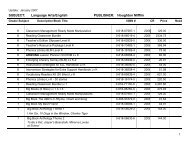
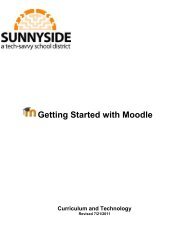

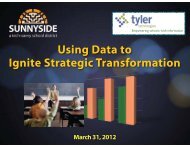

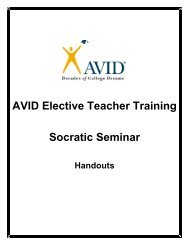
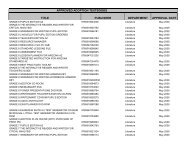
![RFP 11-32-16 (Renewal) Web Based Learning Software [Edgenuity]](https://img.yumpu.com/52314417/1/190x245/rfp-11-32-16-renewal-web-based-learning-software-edgenuity.jpg?quality=85)
